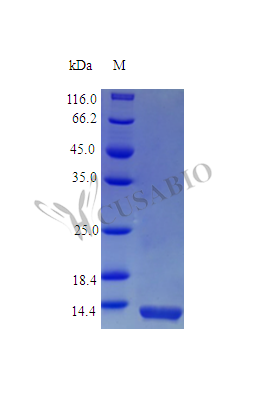Recombinant Mouse Interleukin-13 protein (Il13) is expressed in E. coli, covering the amino acid region M+22-131aa and is tag-free. This partial protein features a purity greater than 97% as determined by SDS-PAGE and maintains an endotoxin level of less than 1.0 EU/μg using the LAL method. It is fully biologically active, with an ED50 of less than 4 ng/ml in a cell proliferation assay with human TF-1 cells, indicating a specific activity greater than 2.5 × 10^5 IU/mg.
Interleukin-13 (IL-13) appears to be a key cytokine in immune response modulation. The protein plays what seems to be a critical role in regulating inflammation and tissue remodeling processes. IL-13 likely influences various signaling pathways that are associated with immune cell differentiation and activation, which may explain why it has become such an important target in immunological research. For scientists studying allergic responses and other immune-related conditions, understanding how IL-13 functions appears essential.
Potential Applications
Note: The applications listed below are based on what we know about this protein's biological functions, published research, and experience from experts in the field. However, we haven't fully tested all of these applications ourselves yet. We'd recommend running some preliminary tests first to make sure they work for your specific research goals.
1. Cell Proliferation and Viability Assays
This recombinant mouse IL-13 protein is confirmed to be biologically active (ED₅₀ < 4 ng/ml in human TF-1 cells) and suitable for stimulating proliferation in responsive cell lines. However, since activity was demonstrated in human cells, validation in mouse-specific cell models is recommended to confirm comparable activity in murine systems. The high purity (>97%) and low endotoxin levels ensure reliable results, but researchers should establish dose-response curves specifically for their target mouse cell types.
2. Cytokine Receptor Binding Studies
The biologically active IL-13 is appropriate for receptor binding studies, but the partial sequence (M+22-131aa) may affect interactions with some receptor components. While the tag-free design ensures authentic binding kinetics, researchers should verify that the truncated protein maintains full receptor binding capability compared to full-length IL-13, particularly for complex formation with IL-13Rα1 and IL-4Rα subunits.
3. Antibody Development and Validation
This high-purity IL-13 serves as a good antigen for antibody development, but the partial sequence may limit epitope coverage. Antibodies generated against this truncated form should be validated for recognition of full-length native IL-13 in mouse biological samples. The confirmed biological activity supports the development of function-blocking antibodies, but comprehensive epitope mapping is recommended.
4. Protein-Protein Interaction Studies
The protein is useful for interaction studies, but the partial sequence could miss important interaction domains present in the full-length protein. While the confirmed activity indicates proper folding of the expressed region, researchers should interpret interaction data with caution and validate any novel interactions with full-length IL-13 when possible.
5. Comparative Cytokine Function Studies
This mouse IL-13 enables cross-species comparisons, but the partial sequence and human cell-based activity validation limit direct functional comparisons. Researchers should conduct parallel activity assays in both human and mouse cell systems to properly interpret species-specific differences, noting that the truncated form may not fully represent native IL-13 behavior.
Final Recommendation & Action Plan
This E. coli-expressed partial mouse IL-13 protein (M+22-131aa) has confirmed biological activity in human TF-1 cells but requires additional validation for optimal use in mouse-specific applications. First, establish its activity profile in relevant mouse cell lines to determine appropriate dosing for murine systems. For receptor studies, verify binding kinetics match those of full-length IL-13. When developing antibodies, ensure they recognize native full-length IL-13 in biological samples. For comparative studies with human IL-13, conduct side-by-side assays in the same cell system to eliminate host cell variability. While the protein's high purity and low endotoxin levels make it suitable for sensitive assays, researchers should acknowledge the limitations of the partial sequence in publications and consider confirming critical findings with full-length IL-13 when possible.






